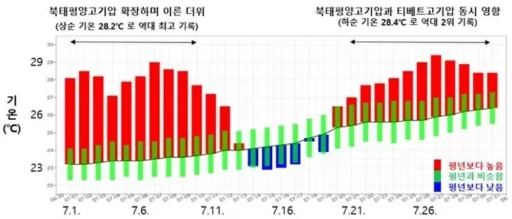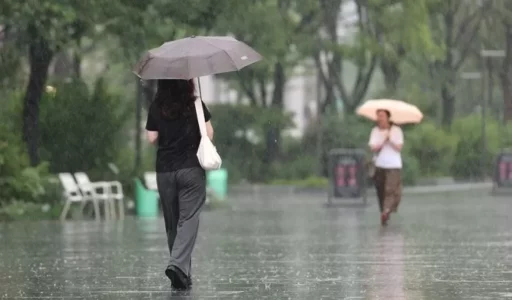July 2025: Extreme Heat Recorded
According to the "Climate Characteristics Report for July 2025" released by the Korea Meteorological Administration on the 5th, the average temperature across the country last month reached 27.1 degrees Celsius, marking the second-highest temperature recorded in July. This figure follows the 27.7 degrees recorded in 1994 and is 2.5 degrees higher than the average.
In particular, the number of heat wave days in July was 14.5, which is more than three times the average (4.1 days). Among 62 observation points nationwide, 31 points experienced heat waves for more than half the month.

Cities such as Gimhae, Cheongju, Daejeon, and Seoul were representative regions. On July 26, for the first time since meteorological observations began in 1971, a heat wave also occurred in Daegwallyeong.
The tropical night phenomenon was also unprecedented, with Seoul recording 23 consecutive days of tropical nights, reaching its highest level in 117 years. This is about 4.8 times the average.
Incheon (22 days), Cheongju (21 days), Mokpo (21 days), and Gangneung (18 days) also recorded the highest number of tropical nights since observations began.

The heat in July concentrated in both the first and last parts of the month. The heat wave, which began at the end of June with the North Pacific High covering the Korean Peninsula, continued until early July, with the average temperature for the first half of July recorded at 28.2 degrees, 4.8 degrees higher than usual, marking the highest ever.
In particular, on July 8, extreme heat surpassed 40 degrees Celsius in places like Uiwang and Gwangmyeong in Gyeonggi Province.
Rising Sea Surface Temperatures Accompanied by Heavy Rain
The sea surface temperature in the waters around the Republic of Korea in July reached 24.6 degrees, the highest in the last ten years. This is 1.3 degrees higher than the average for the past decade, with 23.1 degrees in the Western Sea, 24.1 degrees in the Eastern Sea, and 26.6 degrees in the Southern Sea.
These figures are 1.0 degrees, 1.0 degrees, and 2.0 degrees higher than the averages for the past decade, respectively.
In terms of rainfall, the total national precipitation for July was 249.0 mm, similar to the average (296.5 mm), but it showed a concentration, especially in mid-July.
96.1% (239.4 mm) of July's precipitation fell during the mid-month, and from July 16 to 20, heavy rains of 200-700 mm were recorded nationwide, prompting the issuance of 161 emergency disaster alerts.

There were also significant regional variations in precipitation.
Seosan, Chungnam, recorded cumulative rainfall of 578.3 mm, nearly half of the average annual rainfall (1253.9 mm), while Gwangju and Jeonnam saw over 500 mm, and areas around Jiri Mountain in Gyeongnam (Sancheong, etc.) recorded about 800 mm.
On July 17, Seosan experienced heavy rainfall of 114.9 mm per hour, while Sancheong and Gwangju recorded 86.2 mm and 76.2 mm per hour, respectively, breaking the monthly record for the highest hourly rainfall.
Jang Dong-eun, the head of the Korea Meteorological Administration, stated, "This July saw the heat wave start unusually early, with repeated heavy rains and extreme heat causing significant damage," adding, "The Korea Meteorological Administration will do its best to provide timely weather information to ensure the safety of citizens."
Image source: As the heatwave continues, on the 29th, mirage from the ground heat rises in the Hyodong area of Jeonju, North Jeolla Province. July 29, 2025 / News1. July daily national average temperature time series. Higher temperatures were observed than usual in both the first and last parts of July / Korea Meteorological Administration. On the morning of the 20th, as the rainy season began and a heavy rain warning was issued for all of Seoul, citizens with umbrellas are seen commuting at Gwanghwamun Square in Seoul. June 20, 2025 / News1.


